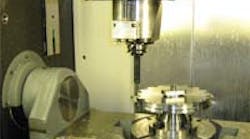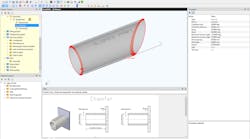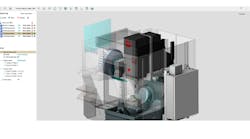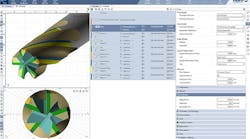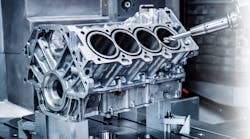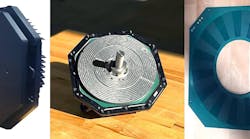Last year’s economic collapse set custom-toolmaker E.W. Tooling Inc., Princeton, Minn., on a hunt for new business, to expand its customer base from woodworking into aerospace and automotive. It has had some initial successes designing tooling for aircraft structural prototypes and a production run of automotive clutch discs, and E.W. Tooling president Todd Wallin credits his employees’ skills and productivity, as well as the company’s five-axis metalcutting capability, and 15 years of experience with polycrystalline diamond (PCD) tooling.
Most of E.W. Tooling’s market has shifted dramatically around it. But, Wallin is confident the shop will continue to transfer its focus to contract machining and tooling for carbon-fiber composites for aerospace and for interior/exterior trim in newer vehicles in development by domestic automakers.
Transferring Advantages
Wallin is convinced that the company can serve all three customer groups, and transfer insights and skills from one sector to another. Tools for composite materials are similar to woodworking tools, he says by way of example. “Our new auto customers will benefit from our toolmaking skills, our costeffectiveness in small quantities for low-initial-rate production, and in fast turnarounds for prototypes.”
E.W. Tooling’s five-axis machining capability is centered on a 5-axis Hermle C600 U trunnion-type machining center. Guiding production on that equipment is Edgecam Advanced Production Milling, Edgecam Solid Machinist from Planit Solutions, and Autodesk’s Inventor for solid modeling.
“We could not produce for our customers without Edgecam and Inventor,” said Wallin. “Solid Machinist and Tool Store keep us competitive in time and cost. I have been using Edgecam since 1999,” he added. “I regularly take it to its limits, going beyond what the software developers intended it to be able to do.”
Most E.W. Tooling products have insertable carbide or brazed-in-place PCD cutters. The latter were developed for heavy-duty vinyl for weatherproof doors and windows: now, the cutters work on the clutch disks, which are a composite material impregnated with graphite and iron powder.
Wallin plans to grow the shop’s industrial woodworking business by changing the way tooling is developed and delivered. Many customers complain about other tooling suppliers’ poor quality products and late delivery, so he hopes to win their business by raising their expectations. And, he expects Edgecam will help in this with speedier programming, faster setups, and more prototypes.
For its core market, kitchen cabinetmaking, E.W. Tooling makes tools for tongue-and-groove and mortise-and-tenon joints, dovetails and mitred window frames and exterior doors. Other tooling is for various decorative pieces, like windowpane dividers, crown moldings, and hand railings. All this tooling falls into a dozen product families, with hundreds of small variations. In addition to the five-axis Hermle, the company has two three-axis milling machines — a Mazak and a Milltronics — plus a two-axis Okuma turning center, a five-axis Schneeberger cutting tool grinder, and four wire EDMs.
Building Flexibility
The challenge is to “retool” E.W. Tooling for the end of the housing boom. Given his cost structure, Wallin is focused on building flexibility with automation: Edgecam five-axis plays a central role.
“What we are really talking about here is flexibility,” said Wallin. “That determines our ability to prosper in a difficult economy, not just to get by, not just to survive. We have to get as much flexibility into the operations as possible. We never know when our search for new opportunities will turn up something completely unexpected. We have to be ready to run with it.”
He expects that five-axis programming and machining “will drastically increase our capabilities for making complex tooling and give our core customers greater productivity.” Five-axis machining — “full five” or “three plus two” — creates the ability to design and machine tooling that is much more complicated than anything threeaxis methods can achieve.
Part of E.W. Tooling’s ability to innovate comes from Solid Machinist, which moves new tool designs into Edgecam. “We use it all the time, multiple times a day, because it lets us access all the CAM functionality from within Inventor,” Wallin said. This ensures that the Edgecam programmer always works with the precise geometry from Inventor and that changes made in Inventor will be reflected in Edgecam, thanks to Solid Machinist associativity.
As for productivity, five-axis machining helps the shop to eliminate nearly all time-consuming secondary setups so that many tool bodies are completely machined in one fixturing. “With our small quantities, staying competitive is all about set-up time,” Wallin pointed out. “Almost all our work is one of a kind. Four or six pieces is a huge order for us, so we are always setting up new jobs.”
Programming with Edgecam offers other dramatic gains. “Edgecam allows us to easily align tool surfaces in the program, then graphically flatten and rotate them until they are perpendicular to the machine tool spindle,” Wallin said. “You just click on the different surfaces, and Edgecam aligns them for you, a big time saver in programming.”
Currently, Wallin is creating programs that are fully post-processed for “lights out” machining. Nearly all his products start as pre-hardened AISI 4140 steel rounds and bar stock, which must be cut slowly, so unattended machining is quite beneficial. But, with no machinists to watch for program errors, “perfect” programs are mandatory. Perfection also means jobs must be machined exactly as programmed. At-the-machine changes by operators can eat into productivity and may even stretch delivery times.
Changing the Game
E.W. Tooling is “attempting to change the way this industry works,” Wallin said, “and we are succeeding. We are deliberately raising the bar on firms that try to compete solely on price.”
The shop is doing that, he continued, “by making sure customers know how much ‘free’ engineering they have been getting from us” — which they would lose if they bought solely on the basis of purchase price. “There is a tendency among some toolmakers in wood and wood-products to look down on these kinds of tooling. Their attitude seems to be, ‘Hey, it’s just a piece of wood’ and ‘This job is way over-engineered.’ We don’t see it that way; we never have.”
The trick in this is to design the new tooling families so that their complexity doesn’t impact E.W. Tooling’s own productivity. Thanks largely to Edgecam’s five-axis capabilities and Solid Machinist with Autodesk Inventor, they don’t.
